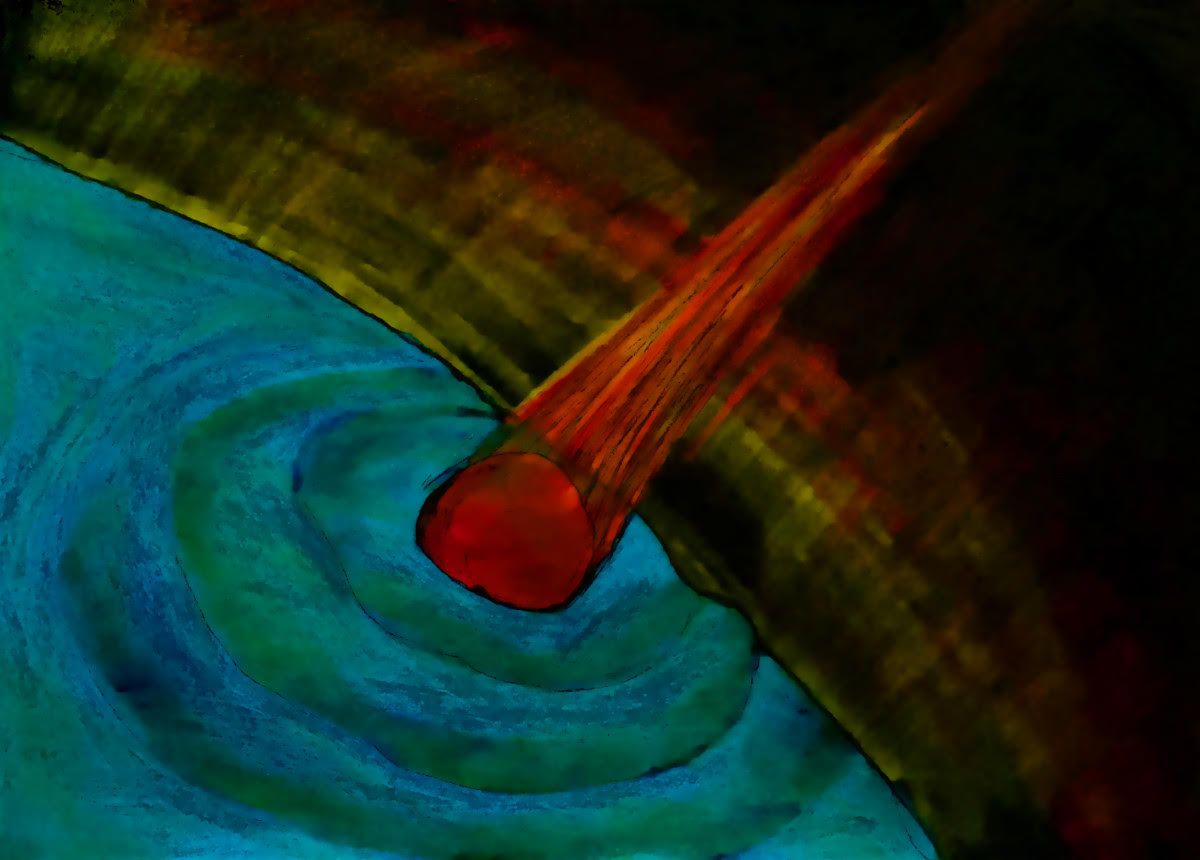The First Continent
Meteors are a destructive force, but they may have created the land we stand on. Or, so the rocks tell us.

Meteors are a destructive force, but they may have created the land we stand on. Or, so the rocks tell us.
Where did the ground we walk on come from? As humans, we tend to take land for granted, despite the fact that, even today, it covers only about a third of the Earth’s surface. What’s more, land is largely two-dimensional. With the exception of tiny burrowing beasts, most of our activity takes place on the surface. The ocean, on the other hand, has a vast third dimension, hosting various kinds of creatures all the way through. “How inappropriate to call this planet Earth”, the science-fiction novelist Arthur C. Clarke once wrote, “when it should quite clearly be called Ocean”.
Be that as it may, we do have our land. And we take it for granted that this land always existed on Earth, albeit in a different form, with a different climate and inhabited by different creatures.
Geology tells us that even this was not the case.
We live in a time of land, but there was once a time when the Earth had no land. How the transition happened remains a mystery, but looking at the composition of existing minerals we can tell quite a lot about continent formation.
Perhaps, by working our way backwards, we can learn the truth about the first continent ever.
Earth, geologically speaking, can be classified into four sections. There's the surface layer called the crust. If the Earth were an apple the crust is the thickness of its skin. We walk on the crust, it makes up all the continents and the seabed. Below the crust is a layer known as the mantle. This layer is thousands of kilometres deep and makes up 84% of the earth's volume. It is understood to be solid but on a geological timescale it behaves like a highly viscous liquid, kind of like caramel. Below this is the liquid outer core and below that is the solid ball of rock known as the inner core.
Continents, by definition, are large masses of land on the crust separated by a fluid like water. With this definition, Earth is the only known planet to have continents. While planets like Mars may have had some similar landmasses in the past, since there is no liquid water on Mars, Earth is the only planet with continents.
In the last century, Alfred Wegener proposed the Continental Drift Theory, according to which Earth once had a unified continent which drifted over time to produce the seven continents that we know today. This theory has been accepted today as fact.
One simple validation of Wegener’s theory can be seen by studying the similarities in the fossils on the different land masses today. For anyone in doubt, notice how nicely the east coast of South America aligns with the west coast of Africa.
The Earth formed 4.6 billion years ago (that’s 4,600,000,000 years!). The era from 4.6 to 4 billion years ago is called the Hadean Aeon, named after Hades, the Greek god of Hell. Scientists previously believed that Earth began as a fiery ball and that over time, the outer surface cooled to form the land we know today. However, we now know that Earth was covered in water before the first continents formed.
This discovery was made thanks to the mineral Zircon.
Crystals of zircon, or ZrSiO4 have a special property. Once formed, they persist even if their parent rock is completely destroyed, they are virtually indestructible. An added bonus is that they are not very rare either.
The age of these minerals can also be easily found by studying their uranium to lead composition. Zircon crystals incorporate uranium and thorium atoms (both most well known as being nuclear fuels). However, these same crystals reject atoms of lead when they form.
Over time, the unstable uranium becomes lead through radioactive decay—which means you can measure the ratio of uranium to lead to figure out how old the crystal is. A young crystal will have a higher proportion of uranium, while in an older one, a relatively higher proportion of uranium would have already turned into lead.
More relevant is the fact that zircon crystals reveal information about the environment in which they formed. This can be deduced through their oxygen isotope ratios.
Oxygen has two stable isotopes: ¹⁸O and ¹⁶O. ¹⁸O, with two more atoms, is heavier than ¹⁶O.
When they rain down, water molecules consisting of ¹⁸O condense more readily than their lighter counterparts. And when evaporation occurs, it’s the ¹⁶O molecules that go away first leaving the ¹⁸O molecules behind. So we can quite reasonably presume that ¹⁶O levels in the oceans were higher during warmer periods, while ¹⁸O dominated during cooler, rainier periods.
It is in these proportions that oxygen atoms are captured in zircon crystals, forming a time capsule or snapshot of the chemical makeup of the time. By looking at zircons we can tell when they were formed and the temperature at the time.
And, with that information, we can infer how exactly those zircon crystals were formed.
In the mantle of the Earth, the oxygen isotope ratio is always around 5.3. A quick note: this doesn’t mean there’s 5.3 times as much ¹⁸O as ¹⁶O. The official name for this value is δ¹⁸O or “delta-O-18”, where the “delta” stands for “difference from ocean water”. So when we compare the ratio here to the ratio in ocean water, the difference is 5.3.
If the value of delta-O-18 is between 0 and 5.3, it means that there was extensive magma interaction with high temperature water before it got solidified to rock. (Naturally, the delta-O-18 value of ocean water is zero, since that’s what we’re comparing everything else to)
If delta-O-18 is greater than 5.3, it means that the magma interacted with the rocks on the earth’s surface, rather than its water. These surface rocks would have previously interacted with rain or ocean water. As mentioned before, rain water contains more of the heavier ¹⁶O. That means rocks would have had more of it too, and, buried and melted into magma, retained that higher value, which would have finally been passed on to our time-capsule zircons during crystallisation.
The oldest zircons have a delta-O-18 about 7.4. That means water must have been abundantly present on the Earth’s surface in the Hadean era. How could this possibly be? After all, it was a time period known for its hellfire and volcanoes.
Geologists have thought about the problem, and come up with their most plausible answer: the water was probably carried to Earth from outer space. The Hadean era was a rough period for the Earth’s surface, which was heavily bombarded by outer-space meteorites. We know this because the land on the Moon shows that these meteoric impacts were regular until 3.5 billion years ago: the remnants of these attacks can be observed today as craters on the Moon.
If the Earth’s surface was almost entirely covered in water, how did the first stable continental nuclei form? Why didn’t any land that formed sink into the magma?
In a new study earlier this year, researchers from three institutions—the Curtin University, the Geological Survey of Western Australia, and the USA’s University of Maryland—got together to investigate land's ancient past. They did this by examining the world’s oldest exposed landmass: Australia’s Pilbara Craton.
A craton is an old and stable part of a continent. This means they’ve remained steadfastly at the surface for millions of years. The Pilbara Craton is one of several continental remnants from the Archaean era, dating 4.0 to 2.5 billion years ago. Following on the heels of the Hadean era, this was around the time that the rate of meteorite impacts were declining on Earth.
By studying the ages of the zircons in the rocks there, and the delta-O-18 values within, the researchers concluded that there were three stages of formation of this craton. What follows is an interesting analysis.
Zircons from the first stage can be categorised into two groups: those whose delta-O-18 values are similar to that of the mantle, just under the Earth’s crust; and those whose oxygen makeup requires a very shallow process. In the second stage, the delta-O-18 matches the mantle. And finally, zircons from stage three have delta-O-18 values requiring interaction with surface materials.
As you can see, it appears like zircons were first formed near the surface, and gradually started forming deeper. But was that really the case? The researchers, having studied the various compositions of the rocks, suggest otherwise.
First (think the researchers), there was a meteoric explosion. A large object rammed into the watery surface of the Earth—a common occurrence back in the day, but this time, the impact caused prolonged exposure of the magma to hot water, and by “prolonged” I mean several million years. The impact itself would have formed magnesium-rich rocks nearby, while iron-rich rocks formed a bit further away. Meanwhile, the combination of magma and hot water caused conditions very like those found in the sub-mantle: so much so that even the oxygen isotope ratios were similar.
During the next hundred-million-odd years, the heavier materials sank into the mantle, while the lighter magmas moved to the surface. This separation allowed the lighter layer to be buoyant and able to stay afloat…eventually forming the “crust” we are familiar with today.
Stage-two zircons are from when the crust stabilised. Magma from the mantle spread around the crust base, which is why stage-two zircons mostly have delta-O-18 values similar to those found in the mantle.
Finally, in the third stage, zircons have above-mantle ratios. This suggests that there was quite a bit of rock from above the base crust that was incorporated into magma below.
The Pilbara Craton tells an interesting story, but what’s more important is that other cratons agree. The same pattern that was observed here, geologists tell us, can be recognized in other cratons as well. This essentially means that meteor explosions were responsible for stabilising the first land on Earth; that every continent belonging to this planet were made possible by giant space rocks crashing into its surface.
We understand meteors as a destructive force. They are always portrayed as a world-ending disaster. Meteors cause explosions; meteors killed the dinosaurs; a meteoroid was the reason behind everyone not wanting to look up.
This perception is partially true, but the cratons tell us that meteors are so much more. Like any natural force, they are both creators and destroyers; they may disrupt the land we’re used to, but before we complain about meteors, we should remember this: they, perhaps, were the ones who gave us the land we live on in the first place.
